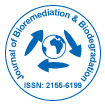Investigating the Role of Pseudomonas aeruginosa in the Bioremediation of Organic Contaminants Mechanisms, Methods, and Challenges
*Corresponding Author: Amara Scarva, Department of Bioscience, Biotechnology and Environment, University of Bari Aldo Moro, Italy, Email: scarvaamara@gmail.comReceived Date: Jan 01, 2025 / Published Date: Jan 30, 2025
Citation: Amara S (2025) Investigating the Role of Pseudomonas aeruginosa in theBioremediation of Organic Contaminants Mechanisms, Methods, and Challenges.J Bioremediat Biodegrad, 16: 664.
Copyright: © 2025 Amara S. This is an open-access article distributed under theterms of the Creative Commons Attribution License, which permits unrestricteduse, distribution, and reproduction in any medium, provided the original author andsource are credited.
Abstract
Pseudomonas aeruginosa is a versatile and resilient bacterium that has gained attention for its potential in the bioremediation of organic contaminants, including hydrocarbons, industrial chemicals, and pesticides. This review investigates the role of P. aeruginosa in degrading a wide range of organic pollutants, focusing on the key mechanisms involved, such as enzyme production, metabolic pathways, and genetic flexibility that enable its survival in polluted environments. The review also explores bioremediation methods leveraging P. aeruginosa, such as bioaugmentation and biostimulation, to enhance the microbial degradation of contaminants in soils, water, and wastewater. Despite i o the promising applications, challenges like environmental conditions, pollutant toxicity, and the bacterium's limited substrate range need to be addressed for improved efficiency. This article provides an in-depth look into the current advancements, opportunities, and challenges in using P. aeruginosa for bioremediation, offering insights into future strategies for optimizing its role in environmental cleanup.

 Spanish
Spanish  Chinese
Chinese  Russian
Russian  German
German  French
French  Japanese
Japanese  Portuguese
Portuguese  Hindi
Hindi 
